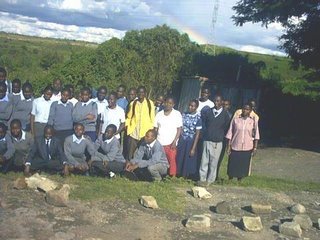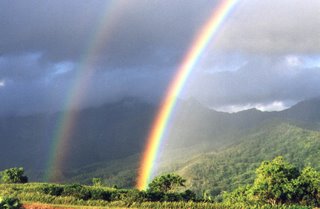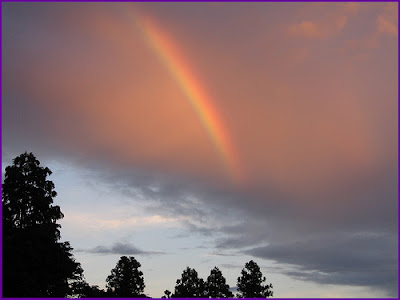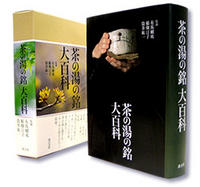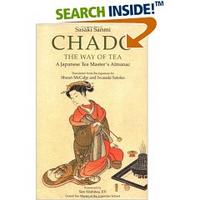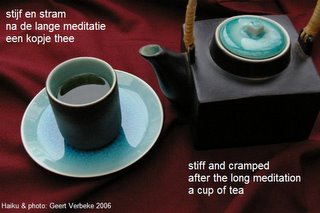. Legends about Amagoi .
:::::::::::::::::::::::::::::::::::::::::::::::::::::::::::::::::::::::::::::::::::::::::::::::::::::
Rain Rituals, Dances and Prayers (amagoi)
***** Location: Japan and other areas
***** Season: Late Summer
***** Category: Humanity
*****************************
Explanation
For a riceplanting culutre like Japan, the seasonal rain is very important, it is a question of life and death! If the rain does not fall enough during the rainy season we have a "Dry Rainy Season" (kara tsuyu 空梅雨), like now in 2005 in Western Japan, where the terraced rice fields in my area did not get enough rain even to prepare the mud fields for planting. Many are not planted at all and the ones who were planted do not have enough to keep them watered. Water reservoirs are dried out...
Whereas in the northern districts of Japan, endless rain has caused the rivers and fields to overflow with water...
the gods of rain
swaying here and there -
floods versus droughts
This is the time when farmers turn to the Gods and Buddhas (kami hotoke) for prayer. There are some kigo related to this.
rain rituals, amagoi 雨乞い
prayer for rain, ame no inori 雨の祈り,
ame inoru 雨祈る
prayer and wish for rain, ki-u (kiu) 祈雨
amulet for rain, ki-u fuda 祈雨札
Sutra when praying for rain, ki-u kyoo
祈雨経, amagoi kyoo 雨乞経
dance when praying for rain, rain dance,
ki-u odori 祈雨踊り
The prayers and rituals for rain take many forms in Japan. Some are accompanied by special dances, some by a lion dance
(shishimai 獅子舞), fires are lit on the tops of mountains and sutras are chanted.
Some Rain Dances and Lion Dances are part of regional festivals held every year in spring or early summer and are quite pleasant events for the population. See the haiku of Shiki below.
But the real Rain Rituals take place during the end of summer, when the weather situation calls for it and the farmers are desperate. They have a quite different severe atmosphere.
In the following, I will try and introduce some of these rituals. Rain Riutals have already been performed during the Nara period and are mentioned in old records like the Nihon Shoki.
In some areas, large boulders are inscribed with the characters for "Jizo", but people came to call them "Jizo who loved Rain" ama koi Jizo 雨恋地蔵 and used them for rain rituals.
Gabi Greve
Reference: Saijiki for Rituals and Ceremonies
:::::::::::::::::::::::::::::::::::::::::::::::::::::::::::::::::::::::::::::::::::::::::::::::::::::
quote
Kiu, shiu
Kiu 祈雨 refers to praying to kami for rainfall and
shiu 止雨 refers to praying to them for the cessation of rain.
Since both are rain-related prayers or rituals,
"rainmaking" (kiu) and "rain-halting" (shiu) are often grouped together.
In the earliest record of court-sponsored rainmaking, Nihon shoki includes an entry on praying to the "all kami " and "all shrines" as well as to "famous mountains and large rivers," mentioning in particular that Empress Kōgyoku personally prayed for rain. In Shoku Nihongi, Emperor Monmu (683-707) offered a horse to the Mikumari kami and prayed for rain in the 4th month of the 2nd year of his reign (699), indicating that rainmaking festivals gradually became performed to worship specific deities.
The practice of attaching the rainmaking function to a specific kami became conspicuous from the reigns of Emperor Shōtoku to Emperor Kōnin (the second half of the eighth century), and Niukawakamisha shrine (now, Niukawakami jinja nakasha) was perceived as the rainmaking deity and named Amashigami.
In the Heian period, Niukawakami Shrine remained the center of rainmaking festivals until the reigns of Emperors Kanmu and Heizei (781-809). In the subsequent reign of Emperor Saga (809-23), Kifunesha shrine (now Kibune jinja) located close to the Heian capital (present-day Kyoto), however, also became a rainmaking deity alongside Niukawakami Shrine.
From around the time of Emperor Saga, rain-halting festivals to pray for the cessation of rain and the control of wind and rain became popular. In rainmaking and rain-halting festivals from the mid-Heian period onward, offerings were being made to eighty-five rainmaking kami, centering around Niukawakami and Kifune Shrines; to these two shrines, black horses were offered at rainmaking festivals and white horses were offered at rain-halting festivals. Thereafter, both types of festivals came to be widely held at non-imperial shrines.
On the other hand, there are numerous examples of rainmaking rituals among the populace, including temporary seclusion in a shrine, rainmaking dances, angering the "Water kami " (suijin) to induce rain, invoking rain by sprinkling around holy water, and summoning rain clouds by sending up smoke from a mountaintop.
source : Shimazu Norifumi, Kokugakuin
:::::::::::::::::::::::::::::::::::::::::::::::::::::::::::::::::::::::::::::::::::::::::::::::::::::
Here is a story about Saint Nichiren and a rain ritual I remember from living close to Gokuraku-Ji in Kamakura. Nichiren is the founder of the Nichiren sect of Buddhism and the welfare of the country was one of his concerns.
In 1271, the country was troubled by persistent drought. The government, fearful of famine, ordered Ryokan, the well-known and respected chief priest of Gokuraku-ji temple, to pray for rain.
When Nichiren Daishonin learned of this, he sent a written challenge to Ryokan offering to become his disciple if the latter succeeded in bringing on rain. If he failed, however, Ryokan was to become the Daishonin’s follower.
Ryokan accepted the challenge, but in spite of his prayers and those of hundreds of assistant priests, no rain fell. Instead, Kamakura was struck by fierce gales. Ryokan not only did not become a disciple of the Daishonin, but actually began to plot against him in collusion with Hei no Saemon.
Read more of the intriques following this unsucessful rain ritual:
http://www.nbaa.tv/Nichiren/lifeofnich.html
:::::::::::::::::::::::::::::::::::::::::::::::::::::::::::::::::::::::::::::::::::::::::::::::::::::
Amagoi Matsuri, Kifune Jinja, March 9
The Great Rain Ritual at this shrine (Kibune Jinja, Kifune Jinja 貴船神社) , which is dedicated to SUIJIN God of Water . This shrine is located at the entrance of the waterways of Kyoto, a most important location in olden times.
Horses offered to the gods in rain rituals
Black and white horse offerings Kibune Shrine 貴船神社の馬
. Kifune Shrine Festivals and Haiku .
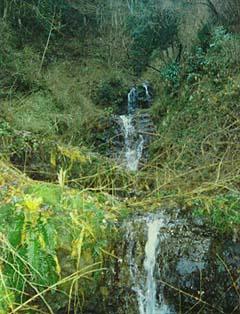
The Waterfall for Rain Rituals, 雨乞の滝
It is not very big and does not carry much water. It falls in three steps.
The Rain Ritual 雨乞祭
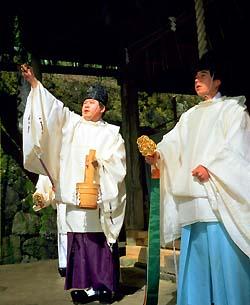
Priests spraying water during the festival.
Suzuka Valley and Waterfall, 鈴鹿谷
The Main Shrine, 貴船神社本宮
The Rock Garden, 石庭
Page with many thumbnails of the places within the precincts.
http://www.kibune.or.jp/meisho/
The Dragon Character of the Deity

高おかみの神の「おかみ」という漢字は (雨かんむりに口を三つ、その下に龍)
Copyright (C) 1997-2000 All Rights Reserved by Kibune Internet Project
http://www.kibune.or.jp/
.................................................................................
. Tamukeyama Hachimangu and Rain Rituals
Tamukeyama Hachiman no tachi ema 手向山八幡の立絵馬
standing votive tablet from Tamukeyama Hachiman shrine
.................................................................................
. Shrine Mimeguri Jinja 三囲神社 / 三囲稲荷社 .
2 Chome-5-17 Mukojima, Sumida, Tokyo
A student of Matsuo Basho named 晋子 Shinshi wrote a poem and after that, it rained.
雨乞や田を見めぐりの神ならば
amagoi ya ta o mimeguri no kami naraba
rain rituals -
if the gods are here now
to see the paddies
. Takarai Kikaku 宝井其角 .
- Enomoto Kikaku (1661-1707)
- Shinshi Ki 晋子忌 Shinshi Memorial Day
:::::::::::::::::::::::::::::::::::::::::::::::::::::::::::::::::::::::::::::::::::::::::::::::::::::
Mount Rain Ritual, Amagoi-dake 雨乞岳

http://www5a.biglobe.ne.jp/~yamaken2/yama/amagoidake.htm
In Shiga prefecture.
...................................................................
The Suzuka Mountain Range
Here the Dragon God resided and people prayed to him for rain. The famous giant "Dadaboshi" who lived there too, heared the people pray and decided to make a water resesrvoir for the people. He started digging and dumped the earth in a place in Suruga province. His pond got bigger and bigger and started fillilng up with water. Now we call this "Lake Biwa" and the place where he dumped the earth is called "Mt. Fuji".
鈴鹿山脈は雨乞い信仰の対象となっていて、山脈の最高峰、御池岳(一二四二メートル)の山頂はカルスト地形の湿地帯、二番目に高い山は雨乞岳(一二三八メートル)で、山頂には小さい池があって、モリアオガエルが棲息する。 山脈の北部には、龍ヶ岳(一一〇〇メートル)があり、御在所山の西には龍王山(八二六メートル)がある。龍王とは、雨乞の水神のことをいう。
昔むかし、鈴鹿の山に「だだぼし」という名の大男がいた。山のように大きかったが、とてもやさしかった。だだぼしは一人で山に住むのがさびしく、里の人たちと遊びたいと思って、「おーい」と呼んだが、里の人にはただの雷に聞こえた。里の人たちが「雷ばっかりで雨が降らない」と雨乞いをするのを見て、だだぼしは溜め池を作ろうと思い立った。夜しか力のでないだだぼしは、夜になると山を下りて穴を掘り、もっこで土を駿河の国へ運んだ。このとき、だだぼしの掘った池は琵琶湖になり、駿河の土の山は富士山になったという。
栗咲いて空の低さよ鈴鹿越え
kuri saite sora no hikusa yo suzuka koe
chestnut blooms
the sky so lowly
Suzuka pass
Kanehisa Michiko 金久美智子
(Tr. Nakamura Sakuo)
http://homepage2.nifty.com/cat-fish/200012hm.html
Detailed Japanese Information about the RainRituals at Suzuka Mountain Range.
From a b ook
鈴鹿山地の雨乞(西尾寿一)
http://blog.livedoor.jp/worldkigo/archives/26597355.html
*****************************
Worldwide use
Kenya
Drought in Kenya is probably not a kigo -- if it were, it would be a rainy season kigo.
During the dry season, dry weather is normal, even desirable, as crops need sunshine to ripen. But during rainy seasons, rain is needed, and if it does not come, we have drought, and we
potentially have famine.
There is a wonderful prayer for rain in the modern Kenyan prayer book, a powerful prayer too. Having once used it during an Evening Service in All Saints' Cathedral Nairobi, several people commented to me afterwards about the beauty of the words and the wonderful way they channelled their prayers.
Prayer for Rain
----------------
Almighty God, Giver of life and strength,
creator of rain and sky, dust and earth,
preserver of people and plants and animals :
as our cattle leave their enclosures,
as we work on a dry and weary land
we look to you, our heavenly showers,
quench our thirst, strengthen our herds,
raise our crops and refresh our land;
Through Jesus Christ, the water of life.
Amen.
(c) Our Modern Services, Anglican Church of Kenya, 2002.
Isabelle Prondzynski
:::::::::::::::::::::::::::::::::::::::::::::::::::::::::::::::::::::::::::::::::::::::::::::::::::::
North America, Indian Rain Dances
Some Links to explore:
Rain Dance of Zuni
This dance is always performed at the Pueblo of Zuni on August 19th. Both men and women participate, and all are masked. ... Zuni Nick says the song varies from year to year, and it is the privilege of all to improvise the new song for each RAIN DANCE.
Learn how to do a real Zuni Indian rain dance.
This site has a lot of other symbolic dances as well.
http://www.inquiry.net/outdoor/native/dance/rain_zuni.htm

turquoise dots
on a black stone frog -
Zuni rain prayer
parched desert -
a small spotted frog
invokes rain
- Shared by Elaine Andre -
Haiku Culture Magazine, 2013
.. .. ..
Island Powwow's Rain Dance Held as Drought Finally Ends
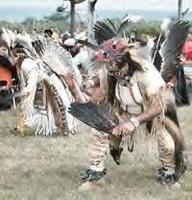
Story of a rain dance held at the opening of a pow wow.
http://www.turtletrack.org/Issues01/Co08252001/CO_08252001_Rain_Dance.htm
.. .. ..
LOWOCC POWWOW PAGE
Pow-wows are the very heart and soul of life for the Native People. Dancing draws man closer to all living things and through them to unseen forces of the Universe itself. Dancing is a way of expressing feeling, whether there is sadness or happiness or a felling of friendliness. It is a way of asking for rain, for good hunting, for good fishing, for success in war.
It is also a way of thanking the Great Spirit for what he has given to his children-food for the hungry, fur to keep warm, rain for the thirst, sun for the crops, and wisdom for the foolish.
An excellent site on Indian dancing that includes details as to how and why they dance, in particular at their pow wows. The asking for rain is just one of many dances performed.
http://www.lowocc.ca/powwowmain.htm
.. .. ..
The Rain that Follows the Sacrifice
By Ida Postma
http://www.theosophy-nw.org/theosnw/world/general/ge-ida.htm
.. .. ..
NATIVE SPIRITUALITY GUIDE
Sponsored byt the RCMP, Royal Canadian Mounted Police.
A very comprehensive site on Indian culture and ceremony.
http://www.rcmp.ca/ccaps/spirit_e.htm
.. .. ..
APACHE NATION
The ceremonies are invariably called "dances. Among these are the rain dance, a puberty right, a harvest and good crop dance, and a spirit dance.
Very extensive esplanations.
http://www.crystalinks.com/apache.html
.. .. ..
First Nations in Canada
An excellent site on the Canadian Pacific Coast Tribes.
http://www.rlc.dcccd.edu/MATHSCI/anth/104/pacific.htm
.. .. ..
Sing Down the Rain
written by Judi Moreillon and illustrated by Michael Chiago
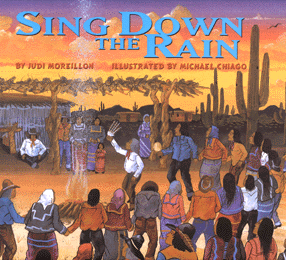
http://storytrail.com/pages/SDRK.html
:::::::::::::::::::::::::::::::::::::::::::::::::::::::::::::::::::::::::::::::::::::::::::::::::::::
Tibet
The Tibetan approach to ecology
by Tenzin P. Atisha
WATER AND RAIN RITUAL
In the third and fourth months in every year rain is scarce in Tibet. The Tibetan Government undertook the following measures to ensure proper rainfall:
First, every year during these months, eight monks from Namgyal monastery were went to seven lakes in and around Lhasa. They would recite special texts to summon the rain.
Second, the Tibetan Government would issue a decree banning construction work, both public and private, when the rainfall was not satisfactory. During the fourth month in particular, construction work was completely stopped.
Third, the Tibetan Government would invite 'gomchen' or hermits who specialized in summoning rain over lakes, to perform special rites in the area around Lhasa.
Finally, if the rain still did not come the government ordered a mass reading of the Kangyur (the doctrine of the Buddha) in the fields for several days. At this time no meat would be served. After completing the reading of the 108 volumes, the scriptures were carried in a circular procession around the fields by monks. The public also joined in this ceremony dressed in their best attire.
Another method employed by government to summon rain was to order the public to play with water in the streets for two or three days. Even the ministers and high lamas were not spared, water was thrown over everyone who went in the streets. This was done during the months of water scarcity to prompt the water god.
Read this most interesting article here:
http://www.tibet.com/Eco/eco7.html
*****************************
Things found on the way
The Park of God's Well in Kyoto
Shinsen-En 神泉苑
Already during the Heian period, a dragon was believed to live in the park and if you pray sincerely to it, rain would fall.
. 神泉苑 Shinsen-En Garden ("Sacred Spring Garden") .
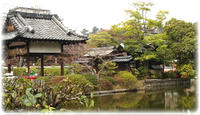
Look at more pictures of this lovely historical park.
http://www.kyonosachi.co.jp/kotomonogatari/yoshitune1
This is the park, where the famous lady Ono no Komachi prayed for rain.
Amagoi Komachi 雨乞小町. Lit. rain prayer Komachi.
Komachi ends a drought by offering the following poem as a prayer for rain:
"It is only reasonable since this is the Land of the Rising Sun for the sun to shine.
Nevertheless it is also called ama-ga-shita" (both 天 [heaven] and 雨 [rain] reads ame/ama).
kotowari ya/hi no moto nareba/teri mo sen/saritote wa mata/ama ga shita to wa
ことはりや/日のもとなれば/てりもせん/さりとては又/天が下とは
Usually depicted is the petitioning Komachi by the shore of a pond in heavy rain with a servant behind her opening a long-hand umbrella.
http://www.aisf.or.jp/~jaanus/deta/n/nanakomachi.htm
The famous priest Kukai, Kobo Daishi 弘法大師 空海 would also perform rain rituals here on behalf of the Tenno.
He recited a special sutra, Shoo-u-Kyoo 請雨経 for seven days in sincere prayer. Then the good dragon godess, 善女竜王, appeared and started to draw dark clouds together and voila! rain fell !
The Rain Sutra 請雨経 in Japanese:
http://blog.livedoor.jp/worldkigo/archives/26581751.html
:::::::::::::::::::::::::::::::::::::::::::::::::::::::::::::::::::::::::::::::::::::::::::::::::::::
quote
Kuraokami, Takaokami 高おかみ神 , Kuramitsuha
Kuraokami no kami, Takaokami no kami
Kami produced from the blood that dripped from Izanagi's sword when he killed the kami of fire, Kagutsuchi.
When Izanagi's consort Izanami gave birth to the kami of fire, she was burned and died. Enraged and saddened at the loss of his wife, Izanagi beheaded Kagutsuchi with his "ten-span sword," and numerous deities were produced from Kagutsuchi's blood.
According to Kojiki, Kuraokami and Kuramitsuha were produced from the blood as it collected on the hilt of Izanagi's sword and dripped through his fingers. According to an "alternate writing" related by Nihongi, Izanagi killed Kagutsuchi by cutting him into three pieces, thus creating the three kami
Ikazuchi no kami, Ōyamatsumi, and Takaokami.
The word kura is said to mean a narrow gorge beneath a cliff, while okami refers to the dragon tutelary of water, and mitsuha suggests the water as it begins to emerge, or a water-spirit.
source : Yumiyama Tatsuya, Kokugakuin, 2005
. 水速女命 Mizuhanome - Deity of water .
. Rain Rituals at Afuri Jinja 阿夫利神社 .
大山 Oyama, Kanagawa
:::::::::::::::::::::::::::::::::::::::::::::::::::::::::::::::::::::::::::::::::::::::::::::::::::::
The Dragon and Rain Rituals
Chinese ideas, such as amagoi, or praying to the dragon-deity for rain (雨乞い), probably accompanied the dragon concept. Such ideas, which probably played important roles in a rice-farming-based culture like the Yayoi, assume that the water-associated dragon-deity has control over natural phenomena such as rain, the lack of rain, hail, and so on.
Read an interesting essay about ancient rain lore.
Dragon in Japan .
http://www2.gol.com/users/bartraj/TheDragon-1.html
:::::::::::::::::::::::::::::::::::::::::::::::::::::::::::::::::::::::::::::::::::::::::::::::::::::
Gunma
Raiden Shrine 雷電神社 Shrine of the Thunder God
In the swamp of the precincts is a dragon, who is the object of the rain rituals.
雷電神社 板倉町
上野国で盛んな雷電信仰の中心的存在。
ここは、古代、万葉集の東歌に「伊奈良の沼」と詠まれた景勝で、境内の雷電沼のほとりにはこの東歌を刻んだ碑が立っております。昔、この沼からは龍駒・龍馬が飛び出したとも、あるいは龍が棲むとも伝えられ、日照りのときに雨乞いを行い、参拝者が身を清める沼でもありました。このほとりには安産・財運・音楽の神を祀る弁天社もあります。
http://www.raiden.or.jp/
Kyoto, Kameoka
Izumo Daijinguu. Great Shrine of Izumo
A special dance is performed.
出雲大神宮 亀岡市丹波国一宮で、明治までは出雲神社と呼ばれていた。徒然草の一文に「丹波に出雲という所あり」と記述されており、そこに出雲大社の分霊を勧請したといわれるが、元々は御影山を神体とし、有力氏族が祀られた社であったとされる。本殿は足利尊氏が修築したもので、三間社流造の檜皮葺。祭礼では雨乞い神事である風流花踊りが知られる。
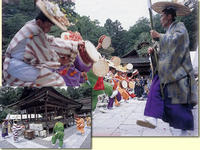
http://www.joho-kyoto.or.jp/~retail/akinai/maturi/maturi_izumo.html
:::::::::::::::::::::::::::::::::::::::::::::::::::::::::::::::::::::::::::::::::::::::::::::::::::::
kigo for late autumn
Niukawakami matsuri 丹生川上祭 (にうかわかみまつり)
Niukawakami festival

A festival for rain rituals at the shrine
Niukawakami Jinja 丹生川上神社
in Nara, October 16
For the rain rituals, a black horse was used to induce rain and a white horse to make a long rain stop.
The shrine became the object of Imperial patronage during the early Heian period.
In 965, Emperor Murakami ordered that Imperial messengers were sent to report important events to the guardian kami of Japan. These heihaku were initially presented to 16 shrines including the Niukawakami Shrine.
© More in the WIKIPEDIA !

:::::::::::::::::::::::::::::::::::::::::::::::::::::::::::::::::::::::::::::::::::::::::::::::::::::
More
. Suijin 水神 God of Water .
Mizu no Kamisama 水の神様
. Mikumarinokami - Mikumari no kami .
and shrines in her name, Mikumari Jinja 水分神社
"Water-dividing kami," tutelaries of the allocation of running water.
:::::::::::::::::::::::::::::::::::::::::::::::::::::::::::::::::::::::::::::::::::::::::::::::::::::

teruteru boozu てるてる坊主 "Teru-teru Bozu dolls"
- quote
The origins of teru teru bozu dolls
The words of the teru teru bozu song hint to us of the tradition’s origins as an ancient superstition similar to a rain spell or chant calling down rain. The difference is that the teru teru bozu spell appears to be a reversal spell to procure not rain, but fair weather. The offering of a golden bell and sake calls to mind the many ancient archaeological artifacts of large numbers of buried bronze bells that have been found in Japan during the Yayoi Period which significantly was when the rice paddy culture was introduced from the continent into Japan. Sake and fruit wines have been traditional offerings to the kami gods since Jomon times. One wonders if there isn’t a connection.
The story that is most commonly known and cited by the Japanese, as explaining the origins of teru teru bozu, however, is this:
There was a monk who promised a village plagued by constant rains that he could stop the rains that were ruining their crops and bring good weather. When the rain continued and the monk was decapitated by the unimpressed villagers.
The story rings true and plausible but hints of far older practices from prehistoric-to-proto-historic times. We know, from the oldest Japanese historical records of the mythological age and of the era of the earliest emperors of Japan, as well as from archaeological excavations (evidence is found in Asuka, Nara and elsewhere) that there was an ancient practice of human and/or animal (horse, cow, etc.) sacrifice to river gods as well as of soothsayers, fortune-bearers and virgin maidens who traveled with seagoing expeditions, and who were thrown overboard to the sea gods as propitious or conciliatory offerings.
According to scholars, the tradition of weather-watchers and a rich folk culture of hiyorimi (weather-watching rituals and practices) can be traced with certainty to Heian period (749 – 1185) continuing through the Edo period (1603 to 1867). It has been suggested that the teru teru bozu weather-watching practice/ritual in particular was adapted from a Chinese practice which involved putting the teru teru bozu on the end of a broom to sweep good spirits your way.
Continue here
- source : japanesemythology.wordpress.com
*****************************
HAIKU
月赤し雨乞踊見に行かん
tsuki akashi amagoi odori mi ni yukan
a red moon -
let us go to see
the rain dance
雨乞や折々のぞく宮の外
amagoi ya oriori nozoku miya no soto
prayers for rain -
once in a while I have a look
outside the shrine
Tr. Gabi Greve
. Masaoka Shiki 正岡子規 visiting shrines and temples .
:::::::::::::::::::::::::::::::::::::::::::::::::::::::::::::::::::::::::::::::::::::::::::::::::::::::
雨乞の竜乗込みて瀬の迅し
ama goi no tatsu nottekomi te se no hayashi
Fujiwara Takao
praying for rain -
the dragon rushes on
to the rapids
(Tr. Nakamura Sakuo)
Japanese Haiku about RAIN
http://homepage2.nifty.com/noura/shiika/amehaiku.htm
xxxxxxxxxxxxxxxxxxxxxxxxxxxxxxxxxxxxxxxxxxx
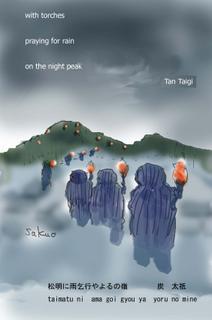
Haiga by Nakamura Sakuo
松明に雨乞行やよるの嶺
taimatsu ni amagoi-gyoo ya yoru no mine
Tan Taigi
rain rituals
in the light of torches -
mountain peaks at night
(Tr. Gabi Greve)
炭 太祇 たん・たいぎ(1738-1791)
http://www.geocities.jp/haikunomori/chuko/taigi2.html
雨乞に夜ひと経よむ僧徒哉
amagoi ni yo hito kyoo yomu zoo kanaa
Kuroyanagi Shoo
for a rain ritual
he reads the sutras -
a monk at night
(Tr. Gabi Greve)
黒柳召波 くろやなぎ・しょうは(1727-1771)
http://www.geocities.jp/haikunomori/chuko/shundei.html
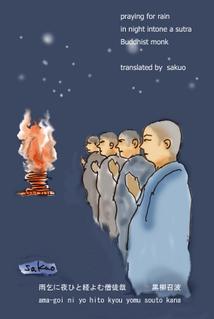
Haiga by Nakamura Sakuo
xxxxxxxxxxxxxxxxxxxxxxxxxxxxxxxxxxxxxxxxxxxxxxxx
Regenzauber, Regenrituale
赤土に雨乞の火を祝女が焚く 新 城 太 石(unbekannt)
aka-tsuchi-ni amagoi-no hi-wo noro-ga taku SHINJOH
Auf der roten Erde/macht die Schamanin Feuer/fuers Regenmachen.
(uebersetzt:TAKANOKURA Yuhki)
the lady shaman
lights a fire on red earth -
rain rituals
(Tr. Gabi Greve)
.. .. ..
雨を乞ふ真夜の火柱立ちにけり 篠 崎 圭 介(1934~)
ame-wo kou mayo-no hibashira tachi-ni-keri SHINOZAKI Keisuke
In der Mitternacht/steht eine Feuersaeule,/um den Regen zu bitten.
(uebersetzt:SATOH Kihakusoh)
a pillar of fire
lights the midnight -
praying for rain
(Tr. Gabi Greve)
http://www008.upp.so-net.ne.jp/kihakuso/html/04sai/natsu04.html
......................................................................................
Another kind of Regenzauber:
Regenzauber -
ein Netz aus gläsernen Perlen
fängt sich den Lichtstreif.
Magie de la pluie -
un filet de perles cristallines
capte le rai de lumière.
magic of rain -
a net of glass pearls
captures the lightbeam
(Tr. Gabi Greve)
Brigitte DORFINGER
http://pages.infinit.net/haiku/autriche.htm
xxxxxxxxxxxxxxxxxxxxxxxxxxxxxxxxxxxxxxx
From the SHIKI archives
head of Waterworks Bureau
prays for rain at the shrine
offering a bottle of sake
*Rain at long last here! Thank Rain-God.
I know a rainmaker who is head of the Waterworks Bureau of Matsuyama City. He sneaked out every morning to make secret prayers at his shrine. He believes that his continuous prayer for rain has been answered this week!
taiko drums
beating the crisp welkin -
villagers dance 'til it rains
(In some remote village it takes place.)
even the dragon
sheds tears of sympathy -
rains of joy for mortals
Takashi Nonin
http://haiku.cc.ehime-u.ac.jp/~shiki/shiki.archive/html/0008/0081.html
:::::::::::::::::::::::::::::::::::::::::::::::::::::::::::::::::::::::::::::::::::::::::::::::::::::::
>... rain dance -
>... dust billows around
>... the dancers feet
parched fields -
a farmer whittles
his own dowser*
*Divining rod to seek out sources of underground water.
Carole MacRury
xxxxxxxxxxxxxxxxxxxxxxxxxxxxxxxxxxxxxxxxxxx
desert dust; lips thirst.
still to watch rain dance, drunken
me with your sweet wet.
Look at the photo go go with this haiku:
http://splashhall.org/2005/05/17/rain-dance-a-haiku/
xxxxxxxxxxxxxxxxxxxxxxxxxxxxx
Nakamura Sakuo and the Issa Haiga
http://blog.livedoor.jp/sakuo3903/
**********************************
Related words
***** .. .. .. .. Rain in various KIGO (Japan)
***** Water Shortage (Tropics)
***** Drought (hideri, Japan)
:::::::::::::::::::::::::::::::::::::::::::::::::::::::::::::::::::::::::::::::::::::::::::::::::::::
Fudo Myo-O and Rain Rituals - Amagoi Fudo -
. Suneori amagoi 脚折雨乞 .
鶴ヶ島 龍神祭 Tsurugashima Dragon Festival
August
.......................................................................
. Legends about Amagoi .
[ . BACK to WORLDKIGO . TOP . ]
[ . BACK to DARUMA MUSEUM TOP . ]
- #amagio #rainritual #regenzauber -
:::::::::::::::::::::::::::::::::::::::::::::::::::::::::::::::::::::::::::::::::::::::::::::::::::::




